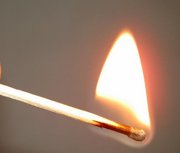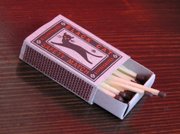Matches


- This article refers to the implement used to create a flame. The term match can also mean a game, or series of games, played between two sports teams.
A match is a simple and convenient means of producing fire under controlled circumstances and on demand. It consists of a short wooden or cardboard stick with a small head of flammable chemicals and a striking surface.
A predecessor of the match, small sticks of pinewood impregnated with sulfur, was developed in China in 577.
The first modern match was invented in 1805 by K. Chancel, assistant to Professor L. J. Thénard of Paris. The head of the match consisted of a mixture of potassium chlorate, sulfur, sugar, and rubber. They were ignited by dipping the tip of the match in a small asbestos bottle filled with sulfuric acid. This kind of match was quite expensive and its usage was dangerous, so Chancel's matches never gained much popularity.
The first friction match was invented by English chemist John Walker in 1827. Early work had been done by Robert Boyle in the 1680s with phosphorus and sulfur, but his efforts had not produced useful results. Walker discovered a mixture of antimony (III) sulfide, potassium chlorate, gum, and starch could be ignited by striking against any rough surface. Walker called the matches congreves, but the process was patented by Samuel Jones and the matches were sold as lucifers. The early matches had a number of problems -- the flame was unsteady and the initial reaction was disconcertingly violent; additionally the odor produced by the burning match was unpleasant. Despite these problems, the new matches were responsible for a marked increase in the number of smokers.
In 1831, Frenchman Charles Sauria added white phosphorus to remove the smell. These new matches had to be kept in an airtight box but were popular. Unfortunately, those involved in the manufacture of the new matches were afflicted with "phossy-jaw" and other bone disorders, and there was enough white phosphorus in one pack to kill a person. There was a vociferous campaign to ban these matches once the dangers became known.

The safety match was invented in 1844 by the Swede Gustaf Erik Pasch and improved by Johan Edvard Lundström a decade later. The safety is due to the separation of the combustible ingredients between the match head and a special striking surface. The striking surface is composed of powdered glass and red phosphorus, and the match head was composed of antimony (III) sulfide and potassium chlorate. The act of striking converts the red phosphorus to white by friction heat; the white phosphorus ignites and the ignition starts the combustion of the match head. The additional safety was the replacement of white phosphorus with red phosphorus. An American company developed a similar match using phosphorus sesquisulfide and patented it in 1910.
The development of a specialised matchbook with both matches and a striking surface did not occur until 1890 with the American Joshua Pusey.
